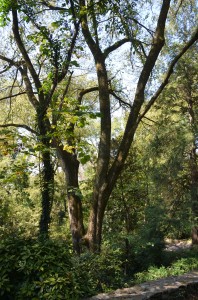American elm (Ulmus americana) once lined America’s city streets until the deadly Dutch elm disease (DED) mostly eliminated it. DED is still present today. Outstanding disease resistant cultivars are truly making a difference, and American elm is on the comeback.
American elm is native to the eastern and central regions of the U. S. and southern Canada (USDA hardiness zones 3 to 9). American elm are related to hackberry (Celtis spp.) and zelkova (Zelkova spp.). There are many species of elm worldwide. Its arching vase shape branching habit is its trademark trait, and this large tree averages 60 to 80 feet in mature height and 25-30 feet in width.
Compared to other landscape trees, American elm is one of the earliest to flower, often in late winter in the Southern Appalachian region (USDA hardiness zones 6 and 7). By late May flowers have set small circular winged seeds (samaras) which float by wind over long distances. Seeds germinate rapidly under favorable conditions.
American elm grows in moist deep soils and full to partial sunlight. It copes with dry average soils, is mostly soil pH insensitive, and tolerates high soil salt levels better than most tree species. Elm withstands brief flooding episodes in spring and fall. Prune elm from mid-summer into fall when potential pest problems are minimal and the internal sap flow is low.
The first line of defense against Dutch elm disease is planting resistant cultivars. American elm is also susceptible to deadly phloem necrosis disease, with symptoms similar to Dutch elm. Elms are subject to numerous insect pests, but rarely threaten their long time survival.
Among the best resistant cultivars with true American elm bloodline, ‘New Harmony’, ‘Valley Forge’, ‘Washington’, and ‘Jefferson’ stand out. Among the Asian – American elm hybrids, ‘Morton’ (Accolade™) is a recommended choice. Accolade elm is also resistant to elm leaf beetle feeding.


 Posted in
Posted in 
